Hey Miss M, please share that popcorn? 
You are using an out of date browser. It may not display this or other websites correctly.
You should upgrade or use an alternative browser.
You should upgrade or use an alternative browser.
FODDER: A beginning. It's comin' along. Final shots.
- Thread starter grumpy
- Start date

Help Support Rabbit Talk Forum:
This site may earn a commission from merchant affiliate
links, including eBay, Amazon, and others.
- Joined
- Jan 20, 2010
- Messages
- 14,520
- Reaction score
- 37
Here ya go!Sagebrush":24y52xq6 said:Hey Miss M, please share that popcorn?
grumpy
Well-known member
Wowser!!!
When this stuff takes off, it really gets with it!!
From this: 18 ounces of barley.
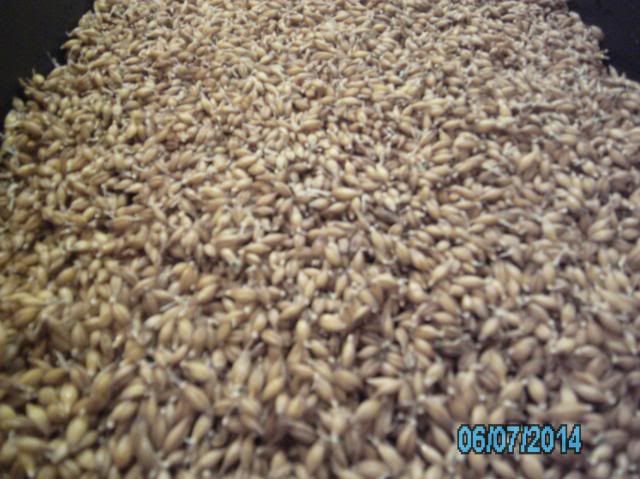
To this: In three days time. It now weighs 50 ounces and we still have four
more days to grow before it will be ready...........(I hope)
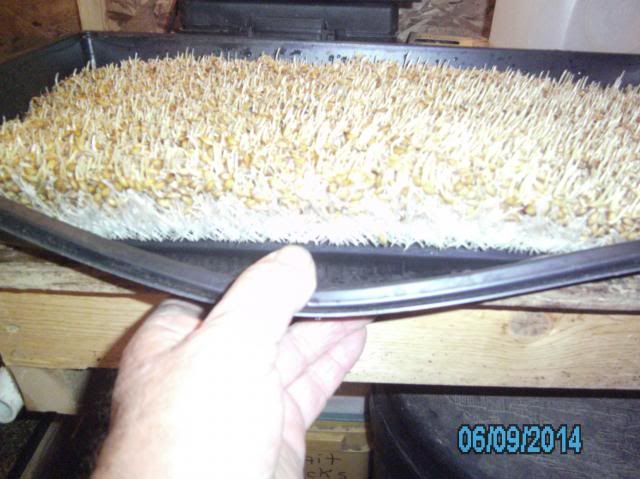
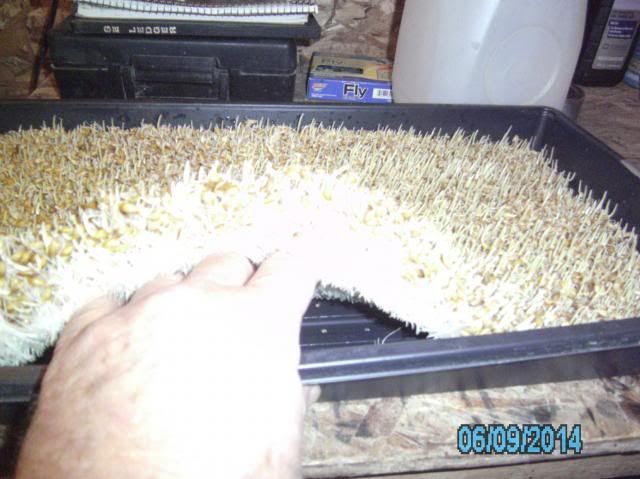
One half of my system is in place. I'll build another unit if this goes as well
as I'm hoping it will.
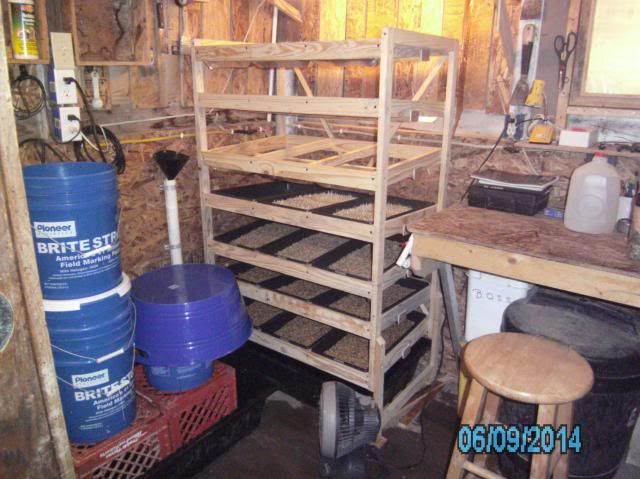
There's one drawback but it's minor. I don't have enough fall in each level.
I have to elevate each tray for about 30 seconds to get the extra water to
drain. I've got an inch and a half fall in each level. Looks like I may have to
increase the fall on the next unit I build. Once I've got the next one built, I
can clear the trays on the original and add more fall to each level. I'll just
have to loosen two screws to make the changes.
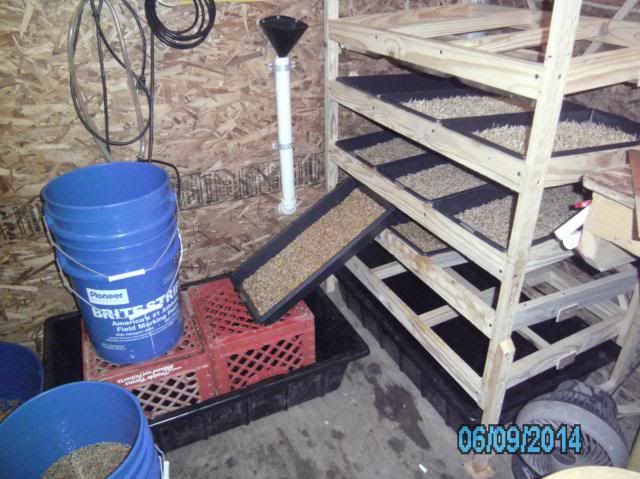
And YES I've taken meticulous notes about the procedures.
I'm just keeping my fingers crossed that this works out okay. Of course,
the cool temps this week have been ideal for a test situation. I'll install a
small room air conditioner and build an insulated door for the room in the
next few days.
Those large tubs are awesome!! They were exactly one-inch too wide
to slip easily under the unit.
You'll note that I cut the legs off and added another set of legs to the
"outside" of the fodder rack. Now, it fits like a finger in a bellybutton. :lol:
It's perfect on the depth and holds 20 gallons of water that can be pumped
out every third day.
More pics as things progress. Keep your fingers crossed.
Grumpy.
__________ Tue Jun 10, 2014 10:00 pm __________
JessiL: Once my initial soak is completed, all I use is fresh water for each
watering. I take water from my reservoir barrels because they are room
temperature. I figure the tap water may be too cold and chill the root
structure which may not be good for the fodder.
But: Thanks for the idea...I may use a teaspoon or so with the watering
sequence.
Grumpy.
When this stuff takes off, it really gets with it!!
From this: 18 ounces of barley.

To this: In three days time. It now weighs 50 ounces and we still have four
more days to grow before it will be ready...........(I hope)


One half of my system is in place. I'll build another unit if this goes as well
as I'm hoping it will.

There's one drawback but it's minor. I don't have enough fall in each level.
I have to elevate each tray for about 30 seconds to get the extra water to
drain. I've got an inch and a half fall in each level. Looks like I may have to
increase the fall on the next unit I build. Once I've got the next one built, I
can clear the trays on the original and add more fall to each level. I'll just
have to loosen two screws to make the changes.

And YES I've taken meticulous notes about the procedures.
I'm just keeping my fingers crossed that this works out okay. Of course,
the cool temps this week have been ideal for a test situation. I'll install a
small room air conditioner and build an insulated door for the room in the
next few days.
Those large tubs are awesome!! They were exactly one-inch too wide
to slip easily under the unit.
You'll note that I cut the legs off and added another set of legs to the
"outside" of the fodder rack. Now, it fits like a finger in a bellybutton. :lol:
It's perfect on the depth and holds 20 gallons of water that can be pumped
out every third day.
More pics as things progress. Keep your fingers crossed.
Grumpy.
__________ Tue Jun 10, 2014 10:00 pm __________
JessiL":3669gtjw said:Looks great. I will be eagerly awaiting reports of how well the rabbits do when transitioned over!
FYI, my fodder producer here discovered that she could almost completely prevent mold issues by using just a bit of hydrogen peroxide in both the soaking and rinsing water. I hadn't heard of that used before (usually it's chlorine bleach), and that made me happy, since hydrogen peroxide will naturally oxidize very fast and just turn into water. Less worry to me that my bunnies were getting too much bleach!
JessiL: Once my initial soak is completed, all I use is fresh water for each
watering. I take water from my reservoir barrels because they are room
temperature. I figure the tap water may be too cold and chill the root
structure which may not be good for the fodder.
But: Thanks for the idea...I may use a teaspoon or so with the watering
sequence.
Grumpy.
- Joined
- Jan 20, 2010
- Messages
- 14,520
- Reaction score
- 37
Looking very nice!!! I'm watching this space. 
grumpy
Well-known member
Miss M":27utf8qk said:Looking very nice!!! I'm watching this space.
Miss M....
Remember that first flat of seeds I showed you? LOL Now....take a look.
It's the one on the far left. It's truly amazing how fast this stuff grows.
The middle flat is 24 hours behind.
The far right flat is 48 hours behind.
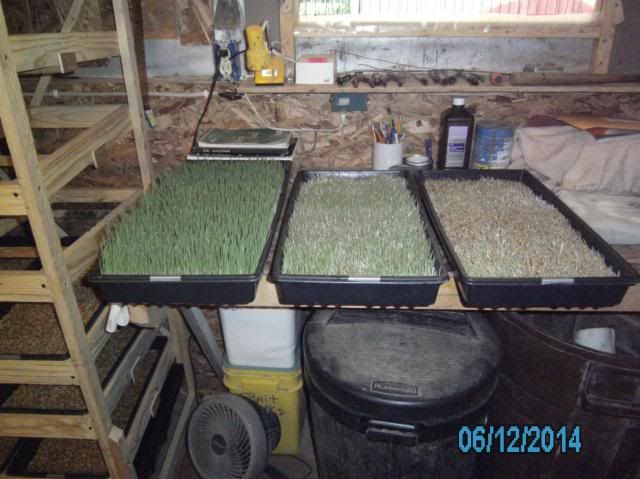
This pic shows the different heights just 24 hours make.
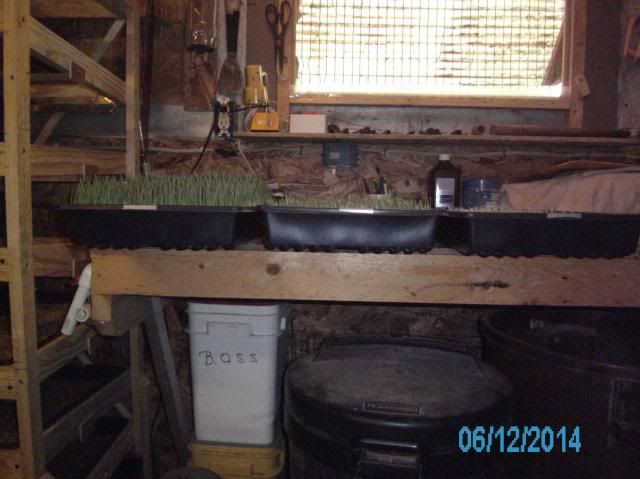
Showin' a little "Green" in the grow-room. The weather has been nearly
perfect for this first attempt. Now, I've got to hustle it up and get the room
completed before really warm weather begins to set in.
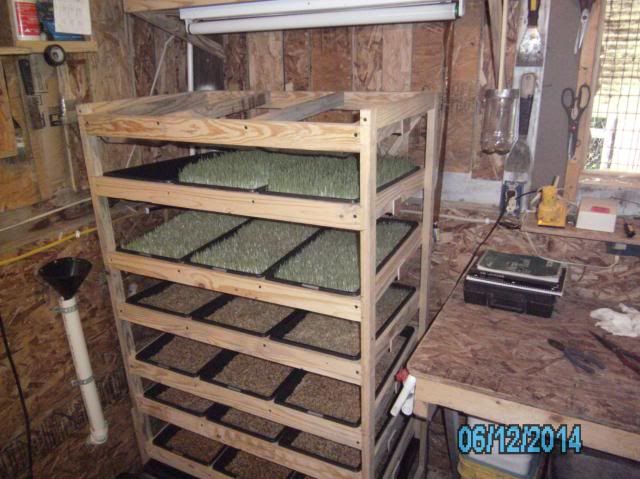
I've been fiddlin' with various weights for each tray throughout the week.
I've came to the conclusion that 16 ounces of dry seed is more than enough
for each flat. Once it has soaked overnight, you'll have over 20 ounces to
spread out evenly.
Some of the trays have 20-22 ounces of dry seed. THAT'S WAY TOO MUCH.
You can see where there is going to be a fair amount of un-sprouted seeds
suspended in the growth. That's a waste that isn't necessary.
Hope you enjoyed. Thanks for lookin'.
Grumpy.
Looking good! I'm glad it's going well!
Miss M and all - I'm afraid I don't know how much hydrogen peroxide. My friend said a "splash" into the bucket for the initial soaking water, and same thing for the rinsing. Maybe Grumpy will get by with just tap water for the rinsing/watering - she was growing hers in a greenhouse with lots of other plants, and perhaps mold was more prevalent there.
Miss M and all - I'm afraid I don't know how much hydrogen peroxide. My friend said a "splash" into the bucket for the initial soaking water, and same thing for the rinsing. Maybe Grumpy will get by with just tap water for the rinsing/watering - she was growing hers in a greenhouse with lots of other plants, and perhaps mold was more prevalent there.

$14.71
$29.99
Fit Men Cook: 100+ Meal Prep Recipes for Men and Women―Always #HealthyAF, Never Boring
Amazon.com

$9.99 ($3.33 / Count)
Springtime 3pcs Rabbit Fur Headbands for Women Girls Unique Faux Furry Hair Headband Soft Luxury Headwear Warm Hair Accessories
Chunxia Accessories

$9.99
$24.00
Top Secret Restaurant Recipes: Creating Kitchen Clones from America's Favorite Restaurant Chains: A Cookbook
Essentialsmerchant

$9.99
$19.95
The Paleo Diet Cookbook: More Than 150 Recipes for Paleo Breakfasts, Lunches, Dinners, Snacks, and Beverages
Kuleli Books

$19.99
$27.99
The Fast Metabolism Diet Cookbook: Eat Even More Food and Lose Even More Weight
Amazon.com

$24.38
$34.95
The Autoimmune Paleo Cookbook: An Allergen-Free Approach to Managing Chronic Illness (US Version)
GoodVibeBooks

$9.99
The Lodge Cast Iron Cookbook: A Treasury of Timeless, Delicious Recipes
Amazon.com Services LLC
- Joined
- Jan 20, 2010
- Messages
- 14,520
- Reaction score
- 37
Wooooooooooooooooow!grumpy":2bbx9n3g said:Miss M....
Remember that first flat of seeds I showed you? LOL Now....take a look.
It's the one on the far left. It's truly amazing how fast this stuff grows.
The middle flat is 24 hours behind.
The far right flat is 48 hours behind.
Oh -- what temp are you keeping your room at? Did you say you'll be keeping it in the 60s? My house is in the mid-70s in the summer.
YES, I enjoyed!grumpy":2bbx9n3g said:Hope you enjoyed. Thanks for lookin'.
I really want to do this as soon as I can! Wish I could get barley around here.
Okay, well that actually does give me something to go on. I really appreciate it!JessiL":2bbx9n3g said:Looking good! I'm glad it's going well!
Miss M and all - I'm afraid I don't know how much hydrogen peroxide. My friend said a "splash" into the bucket for the initial soaking water, and same thing for the rinsing. Maybe Grumpy will get by with just tap water for the rinsing/watering - she was growing hers in a greenhouse with lots of other plants, and perhaps mold was more prevalent there.
grumpy
Well-known member
I've been at the mercy of the weather as far as temperature control.
Fortunately, the weather has been very cooperative all week long with
the temps staying in the high-60's to mid-70's.
Today, is supposed to be nearly perfect in the mid to upper 60's.
Tomorrow however, it's supposed to start warming up past the 80 degree mark.
I'll spend the day locating and buying a used A/C unit. I think I've got one
stored upstairs in the extra bedroom. Not sure about that, though.
PLUS, I've got to construct an insulated door for the grow-room and install it.
If I can keep the room between 67 and 72 degrees, I'll be right in the ball
park on the correct temperature for sprouting. I keep at least one fan
running all of the time to keep good air movement over the seed trays.
My initial rinse is in the water I used to soak the seed overnight. It's just a
quick wash removing part of the dirt and dust, if there is any. I do have
quite a bit of "floating" seeds once the water settles down. But, I don't skim
them off....I leave them in.
I'll raise the bucket up and let the water drain back down into the holding
bucket. Then, I'll take another holding bucket and drop my bucket with the
pump down into a clean water bath. I'll add one capful of bleach to the water
and turn on the pump. Then, I'll dump the rinsed seed into the water bath
and forget it until about 5 or 6 in the evening.
When I'm ready to drain the washed seed, I have to block the water jet with
my finger and turn off the pump, keeping my finger blocking the exit pipe
from the pump. Otherwise, falling seed will quickly clog the impeller of the
pump. Then, you've got a mess to deal with.
I've got my overnight bucket already filled with clean water and a capful of
bleach waiting. I'll dump the washed seed into the water, stir it around
pretty good and leave it for the night. I'll keep it covered so no night time
bugs will get into it. This batch is what goes into the trays the next morning.
I'll weigh out 16 ounces of DRY barley per tray and that is the amount I use in
all of the washing an rinsing.
I water the trays once in the morning BEFORE adding the next group of trays.
The seed is already super wet, so there's no need for anymore water on that
group. I'll water once again in the evening with one gallon of water per
vertical stack of trays. I use the water out of my auto-watering system.
It's room temperature and won't shock the roots as easily as cold water out
of the spigot. I don't use any bleach beyond the initial rinsing and washing.
I'm sure all of this sounds very time consuming and tedious. However, it
takes very little time to do all that is needed and my time that is required
is becoming less and less as I smooth out the methods that I use. It's just
a matter of getting your pattern down to nearly perfect and the time is
shortened dramatically. It took me forever, the first couple of times. But,
after that, it became easier with each attempt.
Hope this is helpful.
Grumpy.
__________ Sat Jun 14, 2014 9:51 pm __________
I've always been blessed/cursed with a "hard-head". Once I begin something,
come Hell or High-Water..........I'll finish it. Typical "Felts" DNA.
What began badly in the last few days of March, has brought me to this point
today. I did a lot of research, read hundred's of pages of dialogue, and quite
frankly "flew" by the seat of my fanny oftentimes. Using logic and good old
common sense I believe I've been fairly successful thus far.
Again, the weather has blessed me, insofar as staying on the cooler side of
comfortable. Tomorrow, this is supposed to change and I'm not quite ready, yet.
Although a first attempt, I'm comfortable with the outcome.
Each morning brings one more set of three trays into production.
However, I don't feed until the early evening hours. That left me with the
first two trays of fodder and no where to place them. Technically, they are
midway through their sixth day of growth. I installed a small span of three
boards elevated to hold the trays until I needed them. What impressed me
was the darkening color of the growth from one day to the next.
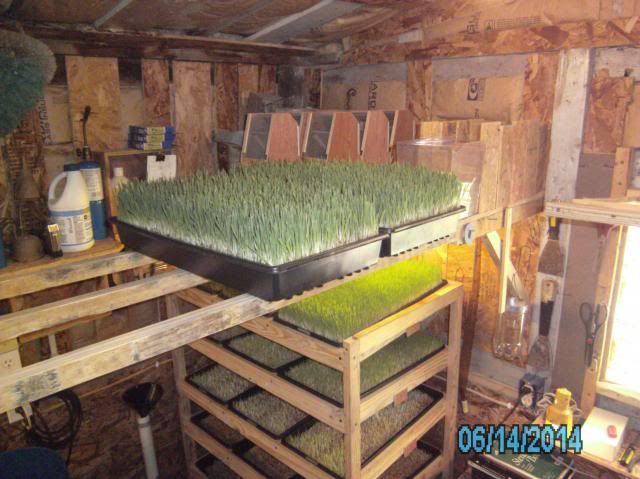
18 ounces of dry Barley per tray was washed and soaked for 24 hours
before being put into the two trays six days ago. 36 ounces turned into
12 pounds and 10 ounces by this afternoon. I watered them early this
morning and made sure they were well drained when I weighed them.
I used a pack of smokes as a size reference.
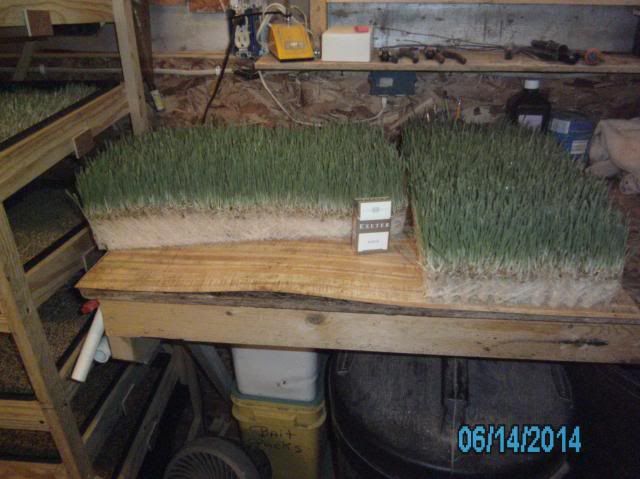
The development of the root system is what really surprised me. It was
very dense and very thick. I didn't see any "bad-spots" on either of them.
BTW: That little black dot on the first one is a darned fly. :x

Kind of like slicing up a very large loaf of bread. LOL. I cut each biscuit into
4 widths then each width into 12 pieces.
Note: My "fly" is still with me. LOL. It's obvious "he" liked it.
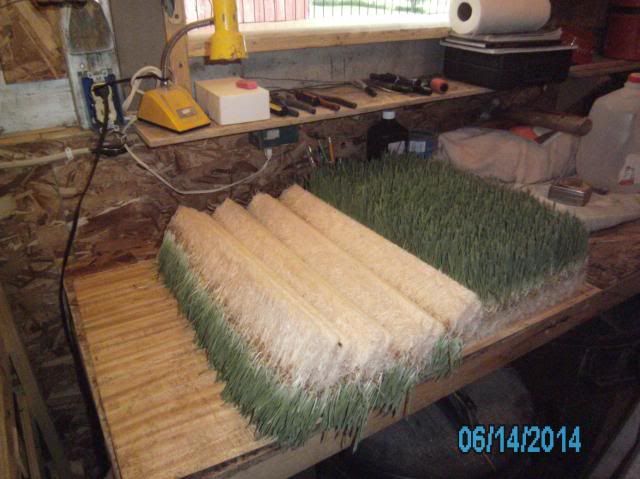
It took a fairly sharp butcher knife to do the job.
I got a nice little tubful of treats.
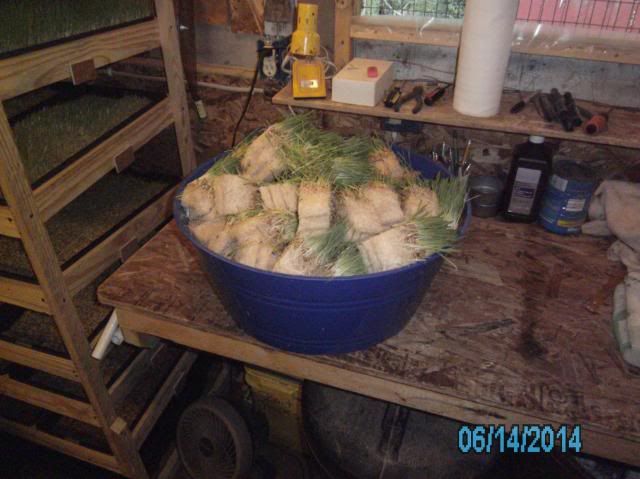
A closing shot of tomorrow's flats. The unit has worked "well" but it could
be better. Hence the reason for constructing only one unit at first. Now,
I can make adjustments in the construction to streamline it a little better.
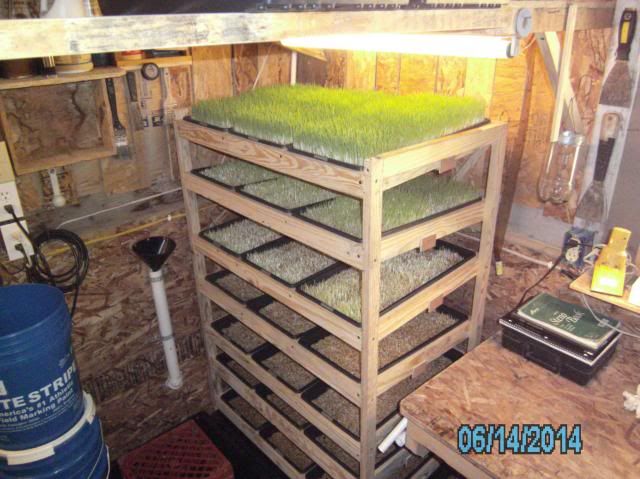
Naturally, there's the $64,000.00 question: "Did the rabbits like it?"
I must answer "YES"........and I must answer "NO". It was a toss-up.
Some jumped on it like a duck on a June-bug. Others.......ho-hum,
what's this? Sniff, nibble, sniff, sniff....a couple of more nibbles.
Some of the does flat worked it over, while others only so-so.
Some liked the roots.........some liked the greens. It was a learning
experience for all concerned.
Hopefully, those that have followed this thread have learned a little about
fodder production. It was a brand new experience for me as well. If I had
failed, rest assured that would have been shared as well. In all honesty, I'm
a little disappointed over the absence of input.
I hope you enjoyed this journey.
Thanks to those that endured the long week.
grumpy.
Fortunately, the weather has been very cooperative all week long with
the temps staying in the high-60's to mid-70's.
Today, is supposed to be nearly perfect in the mid to upper 60's.
Tomorrow however, it's supposed to start warming up past the 80 degree mark.
I'll spend the day locating and buying a used A/C unit. I think I've got one
stored upstairs in the extra bedroom. Not sure about that, though.
PLUS, I've got to construct an insulated door for the grow-room and install it.
If I can keep the room between 67 and 72 degrees, I'll be right in the ball
park on the correct temperature for sprouting. I keep at least one fan
running all of the time to keep good air movement over the seed trays.
My initial rinse is in the water I used to soak the seed overnight. It's just a
quick wash removing part of the dirt and dust, if there is any. I do have
quite a bit of "floating" seeds once the water settles down. But, I don't skim
them off....I leave them in.
I'll raise the bucket up and let the water drain back down into the holding
bucket. Then, I'll take another holding bucket and drop my bucket with the
pump down into a clean water bath. I'll add one capful of bleach to the water
and turn on the pump. Then, I'll dump the rinsed seed into the water bath
and forget it until about 5 or 6 in the evening.
When I'm ready to drain the washed seed, I have to block the water jet with
my finger and turn off the pump, keeping my finger blocking the exit pipe
from the pump. Otherwise, falling seed will quickly clog the impeller of the
pump. Then, you've got a mess to deal with.
I've got my overnight bucket already filled with clean water and a capful of
bleach waiting. I'll dump the washed seed into the water, stir it around
pretty good and leave it for the night. I'll keep it covered so no night time
bugs will get into it. This batch is what goes into the trays the next morning.
I'll weigh out 16 ounces of DRY barley per tray and that is the amount I use in
all of the washing an rinsing.
I water the trays once in the morning BEFORE adding the next group of trays.
The seed is already super wet, so there's no need for anymore water on that
group. I'll water once again in the evening with one gallon of water per
vertical stack of trays. I use the water out of my auto-watering system.
It's room temperature and won't shock the roots as easily as cold water out
of the spigot. I don't use any bleach beyond the initial rinsing and washing.
I'm sure all of this sounds very time consuming and tedious. However, it
takes very little time to do all that is needed and my time that is required
is becoming less and less as I smooth out the methods that I use. It's just
a matter of getting your pattern down to nearly perfect and the time is
shortened dramatically. It took me forever, the first couple of times. But,
after that, it became easier with each attempt.
Hope this is helpful.
Grumpy.
__________ Sat Jun 14, 2014 9:51 pm __________
I've always been blessed/cursed with a "hard-head". Once I begin something,
come Hell or High-Water..........I'll finish it. Typical "Felts" DNA.
What began badly in the last few days of March, has brought me to this point
today. I did a lot of research, read hundred's of pages of dialogue, and quite
frankly "flew" by the seat of my fanny oftentimes. Using logic and good old
common sense I believe I've been fairly successful thus far.
Again, the weather has blessed me, insofar as staying on the cooler side of
comfortable. Tomorrow, this is supposed to change and I'm not quite ready, yet.
Although a first attempt, I'm comfortable with the outcome.
Each morning brings one more set of three trays into production.
However, I don't feed until the early evening hours. That left me with the
first two trays of fodder and no where to place them. Technically, they are
midway through their sixth day of growth. I installed a small span of three
boards elevated to hold the trays until I needed them. What impressed me
was the darkening color of the growth from one day to the next.

18 ounces of dry Barley per tray was washed and soaked for 24 hours
before being put into the two trays six days ago. 36 ounces turned into
12 pounds and 10 ounces by this afternoon. I watered them early this
morning and made sure they were well drained when I weighed them.
I used a pack of smokes as a size reference.

The development of the root system is what really surprised me. It was
very dense and very thick. I didn't see any "bad-spots" on either of them.
BTW: That little black dot on the first one is a darned fly. :x

Kind of like slicing up a very large loaf of bread. LOL. I cut each biscuit into
4 widths then each width into 12 pieces.
Note: My "fly" is still with me. LOL. It's obvious "he" liked it.

It took a fairly sharp butcher knife to do the job.
I got a nice little tubful of treats.

A closing shot of tomorrow's flats. The unit has worked "well" but it could
be better. Hence the reason for constructing only one unit at first. Now,
I can make adjustments in the construction to streamline it a little better.

Naturally, there's the $64,000.00 question: "Did the rabbits like it?"
I must answer "YES"........and I must answer "NO". It was a toss-up.
Some jumped on it like a duck on a June-bug. Others.......ho-hum,
what's this? Sniff, nibble, sniff, sniff....a couple of more nibbles.
Some of the does flat worked it over, while others only so-so.
Some liked the roots.........some liked the greens. It was a learning
experience for all concerned.
Hopefully, those that have followed this thread have learned a little about
fodder production. It was a brand new experience for me as well. If I had
failed, rest assured that would have been shared as well. In all honesty, I'm
a little disappointed over the absence of input.
I hope you enjoyed this journey.
Thanks to those that endured the long week.
grumpy.
ckcs
Well-known member
Looks great. I know fodder can save some coin but how is it as far as labor on your end? How much time do you think it would add to your week by doing it on a full scale?
I think this type / types of systems will be the future of home, and homestead animal production, as we move into the next phase of our civilization, manufactured feeds , and commercial buyers, are pricing them selves out of the small producers market.-- The animal producers are being squeezed as never before. -- and home meat and animal product raisers will have few other options.
-- in watching this trend, I am very interested in production methods that were employed by producers back when they had to grow all of the food for their livestock, and families/ villages themselves.
Thank you, Grumpy
-- in watching this trend, I am very interested in production methods that were employed by producers back when they had to grow all of the food for their livestock, and families/ villages themselves.
Thank you, Grumpy
grumpy
Well-known member
ckcs":qrgujfmp said:Looks great. I know fodder can save some coin but how is it as far as labor on your end? How much time do you think it would add to your week by doing it on a full scale?
Good point!! I've thought about the same thing. It's relative to size first and
foremost. There are days that I feed over 110 pounds of feed. My feed costs
me 27.5 cents per pound. That's right around $30.00 per day. It's expensive.
Starting out on this journey, I was kinda like a "chicken with it's head cut off"
going one way....then another. It took me a few days to develop any form of
routine. Now, it's better, much better time wise. There's still a few kinks in
the system that I'll need to work out to make it more streamlined and quicker.
It's a slow process, but getting better day by day. 20-30 minutes in the
mornings and about 45 minutes in the evenings when I process the fodder
into servable portions. So, about an hour per day right now. That 12+ pounds
of fodder cost me a shade under a nickel a pound. So, roughly 60 cents,
let's say. Now, quadruple that amount and you can see the savings involved.
If I can produce 50-60 pounds of fodder per day and feed it instead of pellets,
the savings will be very significant.
I seriously doubt I'll ever go completely to a fodder based diet. Number one,
you can have a "failure" in a days' production and the stock will go hungry.
We don't want that. Second: Sales of breeding stock will be going to folks
that feed strictly pellets and hay. We've got a problem of drastic diet change
right from the get-go.
I've little to no trust in feed milling companies. PROFIT is their bottom line
nowadays with little to no regard for the ingredients' quality they use. That's
definitely not good for a commercial producer. I am curious though as to the
quality of the fryers produced by a majority of their diet being fodder and hay.
It's GOT to be better. I'd eventually like to get to an 85% fodder, 15% pellet
diet with hay added for higher fiber. With fodder costing under a nickel per
pound versus pellets costing 27.5 cents per pound, it's easy to see the potential.
It's nearly impossible to raise the price of my product on the wholesale level.
But, if I can reduce my expenses, therein lies the potential for more money.
We'll see what happens over the next several months.
Grumpy.
ckcs
Well-known member
grumpy":3pos5ind said:I seriously doubt I'll ever go completely to a fodder based diet. Number one,
you can have a "failure" in a days' production and the stock will go hungry.
We don't want that. Second: Sales of breeding stock will be going to folks
that feed strictly pellets and hay. We've got a problem of drastic diet change
right from the get-go.
Grumpy.
That is a great point and one I hadn't thought of. Thanks for the very informative response.
Grumpy, thanks for all of the information you've shared. I grew fodder over the winter, but on a teeny tiny scale.I raise just enough rabbits to feed my family. It boggled my mind when I looked at the scale you needed to do--far cry from a few dish pans or other containers with drainage holes poked on the bottom. I've learned a lot from what you've done.
My buns have mixed responses to the fodder as well. Some really liked it, some toyed with it. My attitude was " hush and eat your vegetables". It was winter when there's not a lot growing, they are nutritious, and I figured they'd adjust, the same way they did when they transitioned off pellets. They did, though though the picky eaters still looked like they'd rather eat something else. Now, because it's so hot in summer and there is so much fresh fodder, I've not grown sprouted grain because I worried about mold. I may rethink that, with what you're discovering.
I notice a different flavour to fresh fodder/forage/grain fed buns vs pellets, which I like. But to be truthful, I may be looking for a difference and wanting to see it as better. It would be interesting to do a blind, side-by-side taste test comparison.
My buns have mixed responses to the fodder as well. Some really liked it, some toyed with it. My attitude was " hush and eat your vegetables". It was winter when there's not a lot growing, they are nutritious, and I figured they'd adjust, the same way they did when they transitioned off pellets. They did, though though the picky eaters still looked like they'd rather eat something else. Now, because it's so hot in summer and there is so much fresh fodder, I've not grown sprouted grain because I worried about mold. I may rethink that, with what you're discovering.
I notice a different flavour to fresh fodder/forage/grain fed buns vs pellets, which I like. But to be truthful, I may be looking for a difference and wanting to see it as better. It would be interesting to do a blind, side-by-side taste test comparison.
grumpy
Well-known member
the reluctant farmer":2np2jplo said:Grumpy,
I notice a different flavour to fresh fodder/forage/grain fed buns vs pellets, which I like. But to be truthful, I may be looking for a difference and wanting to see it as better. It would be interesting to do a blind, side-by-side taste test comparison.
TRF......
You've raised an interesting subject. One that I've been rolling around in
my mind for quite a long while. "Flavor---due to diet."
I'm an old-school fella with my roots tracing back into a historical family
of hunter/gatherer's. As far back as the early to mid-1800's my ancestor's
have been folks that lived off the fruits of the land. I've eaten just about
every kind of critter imaginable.
Some tasted pretty good.....Some didn't... :x :x :x
As a youngster I was raised on wild rabbits and squirrels. It was then that
I discovered something very NASTY and quite RANCID!!!
NEVER eat a squirrel or rabbit that's been eatin' hedge-apples. The smell
and taste would gag a buzzard.
Now..........let's go to the other end of the spectrum. What if.....while a
young rabbit was growing to market weight, their diet was slightly altered?
What would happen if by chance or by intent, they were given an "apple"
flavored additive in their diet? What if a light spraying of apple juice was
put on their daily fodder biscuit the last ten days before going to market?
Would that affect the delicate flavor of their meat in a very subtle fashion?
Would it even be noticeable? If it was, how would it affect the sales? These
are some of the issues I consider when growing for market. So, you may
have some very strong merit in your beliefs about flavor.
I know for a fact that meat can be changed by diet. Just try to eat a squirrel
that's been dining on Hedge-apples. You can't get past the smell. It's awful.
Grumpy.
Grumpy, I've been trying to reply and my computer kept crashing! You know, that's true--up in the midwest, where my relatives live, the deer used to live off wild forage, branches in winter, and what bits of crops might be left over after dairy farmers hsrvested for their family fsrms. The venison had a distinctly gamey flavour--particularly the swamp bucks. :x But now, 40+ years later, most of the small family farms are gone and a lot of the farmers have converted to commercial crops of acres & acres of soybean and/or corn. The venison I got from there last fall was fat and tasted like beef to me-which made sense, since they are heavily feeding on the same diet being pushed in commercial lots. (I'm also concerned about how the genetically engineered crops will affct wildlife, since they're now the mainstay of the deer's diet.) So I'm probably not imagining the taste difference in the bun meat. I'd be curious about impact of food flavours on meat flavours as well. I'm also interested in if vitamin & mineral content are enhanced in the final meat product--say for instance, in your apple juice experiment, would not only flavour be enhanced but the meat would have enhanced vitamin c? I am curious about the idea, although I see the potential to go too far.grumpy":1ovadxe9 said:You've raised an interesting subject. One that I've been rolling around in
my mind for quite a long while. "Flavor---due to diet."
I know for a fact that meat can be changed by diet. Just try to eat a squirrel
that's been dining on Hedge-apples. You can't get past the smell. It's awful.
Grumpy.
I have noticed a different flavor in rabbits raised on sugar beet , carrot, J artichoke, and grass hay, [and it is not a bad thing] compared to pellets, but-- I also notice a different flavor in rabbits raised on a alfalfa / corn based pellet, compared to the alfalfa / wheat based pellets I use now. I have come to the conclusion that feeding the GMO field corn we have today, [and maybe corn in general], to rabbits is not a good thing. - I want to do a trial with flint corn [non GMO], and see if given a choice between wheat and corn, they will sort it out of their feed, and drop all of it under the cage like they do the "Dent" field corn.
Sorry, I just got a chance to look at this thread but how often do you change out the water? With the trays being tilted does the water make the seed slide to one side a bit? Also how many cups of seed do you put in there? Again, sorry if these answers were answered.
grumpy
Well-known member
mystang89":fk3yqlns said:Sorry, I just got a chance to look at this thread but how often do you change out the water? I use fresh water with every watering.
With the trays being tilted does the water make the seed slide to one side a bit? Only on the first tray. Afterwards, the root system holds itself in place.
Also how many cups of seed do you put in there?
18 ounces of Dry seed PER TRAY is measured then soaked overnight before being placed in the trays.
Again, sorry if these answers were answered.
Hope this helps.
grumpy
Well-known member
mystang89":3jfueb97 said:Thanks, how big are your trays?
They're the standard 1020 greenhouse trays with solid bottoms.
I drill the holes in the bottoms where I want them.
10" X 20" size about 2.75" deep.
grumpy.
























